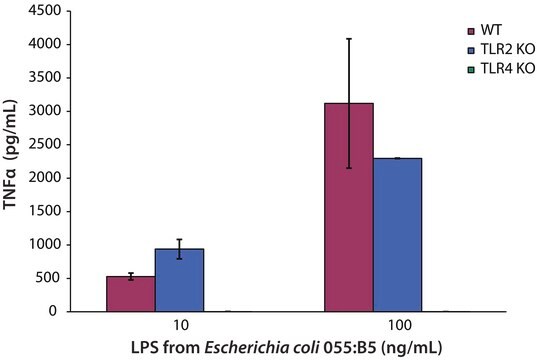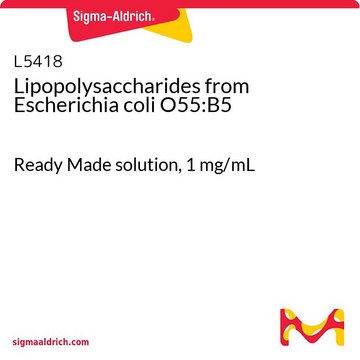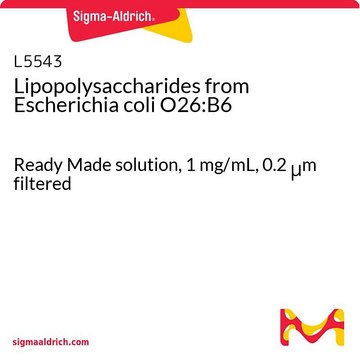L6529
Lipopolissacarídeos
γ-irradiated, BioXtra, suitable for cell culture
Sinônimo(s):
LPS
About This Item
Produtos recomendados
fonte biológica
Escherichia coli (O55:B5)
Nível de qualidade
esterilidade
γ-irradiated
linha de produto
BioXtra
forma
lyophilized powder
purificado por
gel-filtration chromatography
técnica(s)
cell culture | mammalian: suitable
Impurezas
<3% Protein (Lowry)
solubilidade
H2O: 5 mg/mL, faintly hazy to hazy
temperatura de armazenamento
2-8°C
Procurando produtos similares? Visita Guia de comparação de produtos
Descrição geral
Aplicação
- to stimulate human PBMC to secrete cytokine.
- to stimulate wild type embryonic fibroblasts and mutants for the induction of phosphorylation of p56
- in the measurement of tumor necrosis factor-α levels and nuclear factor-κB p65 activities after stimulation
- in the stimulation of hamster lymphocytes in vitro
- to induce activated dendritic morphology in murine macrophage cell line in a study
Ações bioquímicas/fisiológicas
Reconstituição
Outras notas
produto relacionado
Palavra indicadora
Danger
Frases de perigo
Declarações de precaução
Classificações de perigo
Acute Tox. 2 Oral
Código de classe de armazenamento
6.1A - Combustible acute toxic Cat. 1 and 2 / very toxic hazardous materials
Classe de risco de água (WGK)
WGK 3
Ponto de fulgor (°F)
Not applicable
Ponto de fulgor (°C)
Not applicable
Equipamento de proteção individual
Eyeshields, Gloves, type N95 (US)
Certificados de análise (COA)
Busque Certificados de análise (COA) digitando o Número do Lote do produto. Os números de lote e remessa podem ser encontrados no rótulo de um produto após a palavra “Lot” ou “Batch”.
Já possui este produto?
Encontre a documentação dos produtos que você adquiriu recentemente na biblioteca de documentos.
Os clientes também visualizaram
Artigos
An overview of human microbiome research, workflow challenges, sequencing, library production, data analysis, and available microbiome reagents to support your research.
Nossa equipe de cientistas tem experiência em todas as áreas de pesquisa, incluindo Life Sciences, ciência de materiais, síntese química, cromatografia, química analítica e muitas outras.
Entre em contato com a assistência técnica




